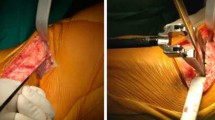Abstract
The technology for producing demineralized bone allografts (DBA) with definable degree of demineralization and sterilization by high energy electron bean was developed in the tissue bank of Central Institute of Traumatology and Orthopaedics (CITO). The authors consider the technology to be one of the ways of producing demineralized bones. The results of the experiments show that time of demineralization process as well as the absorption dose of radioactive high energy electron beam change substantially mechanical toughness and osteoinductive properties of DBA. Mechanical properties of DBA were tested by the universal testing machine 'Zwick 1464'. Quantitative assessment of DBA osteoinductive properties resulted from the investigation of DBA samples in the culture of stromal precursor bone marrow cells and in the culture of human skin fibroblasts. Cloning efficiency of fibroblasts was considered as indecies of proliferative potential of stromal bone marrow cells, i.e. osteogenic precursor cells. The growth of the cell mass after definite time as well as the index of 3H-timidin marked cells within biological inductor were considered as indecies of proliferative potential of skin fibroblasts. The obtained results showed, that inductive properties of allografts improve when the degree of their demineralization increases whereas the dose of high energy electron radiation decreases. Mechanical toughness of DBA deteriorates when both degree of their demineralization and radiation doses increase. This emphasizes the importance of optimizing technological stages in DBA producing. Since 1998 DBA have been used in Russian clinics for bone plasty in traumatology and orthopaedics, maxilla-facial surgery, ophthalmology, and neurosurgery. The resulting analysis is based on case histories of 257 patients operated from March 1998 to July 2002. The majority of patients were children and teenagers of 3–18 years old with prime tumors, tumor-like and systemic inherited diseases of skeleton, post-traumatic complications. Observation periods were from 1.5 to 5 years and 10 months. Good and satisfactory results were obtained in 93.4% cases.
Similar content being viewed by others
References
Dziec-Goclawska A. 2000. The application of ionizing radia-tion to sterilize connective tissue allografts. Radiation and Tissue Banking. IAEA, World Scientific, Singapore, pp. 57–99.
Mironov S. P., Snetkov A. I. and Lekishvili M. V. 2002. Alloplasty in conjunction with metalloosteosynthesis for bone defects replacement in paediatrics of tumour-like pathologies of skeleton. In: Phillips G. O. (ed. ), Advances in Tissue Banking, Vol 6. World Scientific, pp. 89–99.
Snetkov A. I., Lekishvili M. V. and Kasymov I. A. et al. 2003. Application of plastic material 'Perfoost' at the clinic of children bone pathology. Vestn. Traumatol. Orthopaed. (Russia) 4:74–79.
Von Versen R. 1993. Preparation of demineralized bone matrix for clinical application. In: Saveliev V. I. (eds. ), Sb. Nauchn. Tr. Demineralized Bone Allograft and its Application (Rus-sia), pp. 4–11.
Author information
Authors and Affiliations
Rights and permissions
About this article
Cite this article
Lekishvili, M., Snetkov, A., Vasiliev, M. et al. Experimental and clinical study of the demineralized bone allografts manufactured in the tissue bank of CITO. Cell Tissue Banking 5, 231–238 (2004). https://doi.org/10.1007/s10561-004-1443-y
Issue Date:
DOI: https://doi.org/10.1007/s10561-004-1443-y




